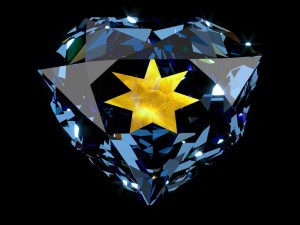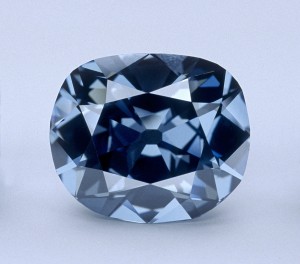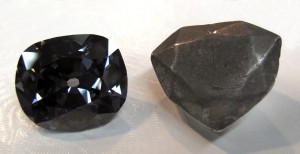
A computer simulation of how the Hope Diamond likely appeared when it was owned by King Louis XIV of France. The sunburst inside the stone results from specially-cut facets on its back, which produce a translucent area that conveys the color of the diamond’s gold mounting. (Image by François Farges)
New research indicates that the stone was once specially cut to produce an image of a sun when mounted on a gold background
Every day, thousands of visitors to the Smithsonian Natural History Museum crowd around a glass case on the second floor to gaze at the Hope Diamond, one of the world’s most famous jewels. It’s been the subject of dozens of books, documentaries and scientific inquiries, partly due to persisting legends that it’s cursed. Despite all this attention, though, it seems that the inch-wide, 45.52-carat diamond still conceals secrets waiting to be uncovered.
One of these secrets was recently discovered by François Farges, a professor of mineralogy at the National d’Histoire Naturelle in Paris, and Jeffrey Post, the Smithsonian museum’s curator of minerals. Using computer modeling, a recently-rediscovered 17th century lead replica and scientific analysis, they’ve determined that back when the Hope was known as the “French Blue” and part of the personal collection of King Louis XIV of France, during the late 17th century, it was likely placed on a gold background and specially cut to produce an effect reminiscent of a sun at its center. Only after it was stolen in 1792, during the French Revolution—and before it resurfaced in Britain in 1812—was it recut to the familiar, smaller shape we know today.
Their new discovery, described in an article published in the month’s Rocks and Minerals magazine, stems from Farges’ 2009 discovery of a lead replica of the French Blue in the National d’Histoire Naturelle mineral collections, which provided the exact dimensions of King Louis XIV’s French Blue for the first time. Both Post and Farges are mineral scientists, and much of their other work on the Hope is concerned with the science behind its distinctive hue, but they’ve also used the tools of science to investigate the gem’s complex provenance.
And the history of the diamond is a complex one: It was bought somewhere in India in a rougher, less finely-cut shape by Jean-Baptiste Tavernier, a French merchant, and brought to France in 1668. “Unfortunately, Tavernier wrote some really wonderful journals about the trip, but nowhere in them did he say anything about where he actually bought the diamond,” Post says. It’s believed that the stone was plucked from the Kollur Mine, in what’s now the southern state of Andhra Pradesh, but no one knows for sure.
From there, it became part of the French crown jewels, and was cut by Jean Pittan, one of King Louis XIV’s court jewelers, sometime between 1669 and 1672, eventually becoming known as the French Blue. That the Hope and the French Blue were the same stone was suggested by diamond experts as far back as 1858, but only proved definitively in 2009, when Farges unearthed the lead replica at the Paris museum. At the time, jewelers made metal replicas for extremely precious stones and used them as placeholders when designing settings.
“They didn’t even know they had it. It was in their collection, but filed under lead specimens,” Post says. Drawings and descriptions of the French Blue had previously suggested it could have been recut to produce the Hope, but the exact physical dimensions provided by the lead replica allowed Farges to collect digital 3D measurements that would prove it. When they compared these measurements to those of the Hope, “it fit into the French Blue perfectly—you could see exactly how the French Blue was cut to form the Hope,” says Post.
The replica, though, also raised a question: Why was the French Blue cut into such an uncommon shape?
Nowadays, when jewelers cut diamonds, they use sharp angles on the back of the stone—always higher than 23 degrees, the critical angle of diamond, so that light that enters the gem reflects inside it several times. The ubiquitous brilliant cut, for instance, is designed to maximize the number of reflections that light entering the diamond encounters, thus maximizing the distance that light travels within the diamond. This heightens the brilliance for the viewer.
But the back of the French Blue had low angles and even an entirely flat culet on its back, allowing some light to travel through and straight out the back of the stone. Compared to the rest of the stone, the material right in front of the culet at the gem’s center would have appeared relatively clear and colorless, almost like looking through a glass window.
Farges and Post’s intriguing explanation: that the jeweler intended for the center of the stone to serve as a window. Along with the flat culet, the French Blue had a series of star-shaped facets that were also below the critical angle, which would have caused the region in front of them to also appear relatively clear.
A 1691 inventory of the French Crown Jewels notes that the gem was “set into gold and mounted on a stick.” If placed in front of a gold sheet, they realized, these unique cuts would have caused a dazzling golden sun to appear at the center of the deep blue stone.
Farges and Post have used computer modeling to produce an image that simulates exactly how this would have appeared, shown above. “King Louis XIV was the ‘Sun King,’ and so this would have been an emblem representing his power,” Post says. “His colors were blue and gold, and so to have a blue diamond with a gold sun in the center—that’d be something that no one else has, something that would almost seem divine.”
The researchers are planning on comissioning a cubic zirconia replica, cut and colored to match the French Blue, which would demonstrate this effect and could someday be put on display with the Hope to illustrate the stone’s transformation and history. They’re also scrutinizing archives of Louis XIV’s jewelers from that era to look for conclusive evidence that this design was intentional.
One thing they know for sure is that the sun effect was eradicated around 1749, when the Sun King’s great-grandson, King Louis XV, ordered the stone to be lifted from its mounting and incorporated into an elaborate emblem. During the French Revolution, it was stolen along with the rest of the Crown Jewels, and although most of the other gems were recovered by French officials, the famous French Blue disappeared. The slightly smaller Hope Diamond—which we now know was cut from the French Blue—was first documented as being in London in 1812, and became well known when it showed up in the collection catalogue of banker Henry Philip Hope in 1839.
More than a half century after it was donated to the Smithsonian in 1958, the Hope is still one of the Natural History Museum’s most-visited and well-known artifacts. “It speaks to the remarkable power of a gemstone. It has generated so much research, interest and curiosity, and it’s focused people on a history that might otherwise go untold,” Post says. “All due to a gem one inch in diameter.”
Correction: An earlier version of this story incorrectly stated that Louis XV was the son of Louis XIV. He was the great-grandson of XIV. Many thanks to reader Joshua Stopple for catching the error.
By Joseph Stromberg
January 28, 2014
For
Smithsonian.com


